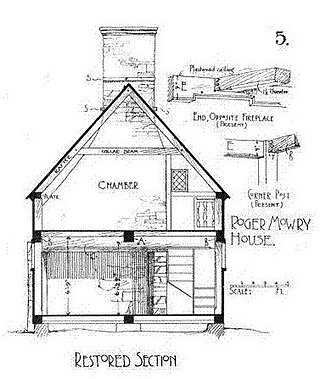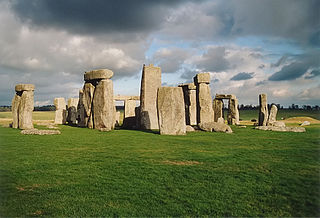Horatio Rogers.[4]
Horatio Rogers.[15]
Related Research Articles

Richard Upjohn was a British-American architect who emigrated to the United States and became most famous for his Gothic Revival churches. He was partially responsible for launching the movement to popularity in the United States. Upjohn also did extensive work in and helped to popularize the Italianate style. He was a founder and the first president of the American Institute of Architects. His son, Richard Michell Upjohn, (1828-1903), was also a well-known architect and served as a partner in his continued architectural firm in New York.

Randolph Rogers was an American Neoclassical sculptor. An expatriate who lived most of his life in Italy, his works ranged from popular subjects to major commissions, including the Columbus Doors at the U.S. Capitol and American Civil War monuments.
Nathan Hale was an American Revolutionary War officer who fought in the Battle of Lexington and Concord, Battle of Bunker Hill, and the Siege of Fort Ticonderoga, Hale was caught at British borders in Manhattan, New York and died as a POW at the age of 21.

The 2nd Rhode Island Infantry Regiment was an infantry regiment composed of volunteers from the state of Rhode Island that served with the Union Army in the American Civil War. They, along with the 1st Rhode Island, wore a very simple uniform. The uniform composed of a dark blue jacket like shirt, tannish grey pants, and a dark blue chasseur kepi. The 2nd Rhode Island also wore havelocks in the beginning of the war, but after finding them useless they discarded them.

Stone, Carpenter & Willson was a Providence, Rhode Island–based architectural firm in the late 19th and early 20th Centuries. It was named for the partners Alfred Stone (1834–1908), Charles E. Carpenter (1845–1923). and Edmund R. Willson (1856–1906). The firm was one of the state's most prominent.
Edward Tuckerman Potter was an American architect best known for designing the 1871 Mark Twain House in Hartford, Connecticut. With his half-brother William Appleton Potter, he also designed Nott Memorial Hall (1858–79) at his alma mater, Union College, Schenectady, New York. Both the Mark Twain House and Nott Memorial Hall are National Historic Landmarks.

Ebenezer Stevens was a lieutenant colonel in the Continental Army during the American Revolution, a major general in the New York state militia, and a New York City merchant.

Norman Morrison Isham (1864–1943) was a prominent architectural historian, author, and professor at Brown University and Rhode Island School of Design (RISD). He was an ardent preservationist and a pioneer in the study of early American architecture.

The state of Rhode Island during the American Civil War remained loyal to the Union, as did the other states of New England. Rhode Island furnished 25,236 fighting men to the Union Army, of which 1,685 died. The state used its industrial capacity to supply the Union Army with the materials needed to win the war. Rhode Island's continued growth and modernization led to the creation of an urban mass transit system and improved health and sanitation programs.

William Carpenter was a co-founder of Rhode Island and Providence Plantations, born about 1610, probably in Amesbury, Wiltshire, England. He died September 7, 1685, in the Pawtuxet section of Providence, now in Cranston, Rhode Island. He was listed by 1655 as a "freeman" of the colony.
Thomas Angell (c.1616–1694) was one of the four men who wintered with Roger Williams at Seekonk, Plymouth Colony in early 1636, and then joined him in founding the settlement of Providence Plantation in what became the Colony of Rhode Island and Providence Plantations. He was a minor at the time of his arrival, but his name appears on several of the early documents related to the settlement of Providence. In the early 1650s, he became active in the affairs of the town, serving as commissioner, juryman, and constable. In 1658, he began his service as the Providence Town Clerk and held this position for 17 years. He wrote his will in 1685, dying almost a decade later in 1694, leaving a widow and many grown children. Angell Street on Providence's East Side is named for him.
The following list is a Bibliography of American Civil War Union military unit histories. More details on each book are available at WorldCat.

Alpheus C. Morse (1818-1893) was an American architect with offices in Providence, Rhode Island.
Major-General James Murray Hadden was a British Army officer and surveyor-general of the ordnance.
Percy Daniels was an American soldier, businessman, civil engineer, surveyor, author and Populist politician.

James C. Bucklin (1801-1890) was an American architect working in Providence, Rhode Island.

William R. Walker was an American architect from Providence, Rhode Island, who was later the senior partner of William R. Walker & Son.
Joshua Melancthon Addeman (1840–1930) served as Secretary of State of Rhode Island from 1872 to 1887.
John Smith was a founding settler of Providence in what would become the Colony of Rhode Island and Providence Plantations. Smith joined Roger Williams at the Seekonk River in 1636 after both were expelled from Massachusetts Bay Colony. In the spring they crossed the river to found Providence where Smith later built and operated the town's gristmill.
References
- 1 2 3 4 5 6 7 8 9 10 11 12 13 "Horatio Rogers, Jr (1836 – 1904) - Find A Grave Memorial". www.findagrave.com. Retrieved 2017-07-11.
- 1 2 Rogers, Horatio (1898). The Influence of College Inspiration on After Life. Providence, Rhode Island: Preston and Rounds Co.
- ↑ "Monument to the 2nd Rhode Island at Gettysburg". The Battle of Gettysburg. Retrieved 2017-07-11.
- 1 2 3 4 Hadden, James Murray; Rogers, Horatio; Burgoyne, John; Phillips, William (1884). Hadden's Journal and Orderly Books: A Journal Kept in Canada and Upon Burgoyne's Campaign in 1776 and 1777. J. Munsell's Sons.
Horatio Rogers.
- 1 2 Acts and Resolves Passed At the May Session of the General Assembly of the State of Rhode Island and Providence Plantations, 1865. Providence, Rhode Island: Hiram H. Thomas & Co. 1865. p. 173.
- 1 2 "Rhode Island National Union Convention". The New York Times. 1864-03-16. Retrieved 2017-07-10.
- ↑ Stattler, Rick (1997). "Amos D. and James Y. Smith Collection". Rhode Island Historical Society.
- ↑ The American Annual Cyclopedia and Register of Important Events of the year 1891, Volume 31, p. 770.
- ↑ William McKenzie Woodward and Edward F. Sanderson, Providence: A Citywide Survey of Historic Resources, ed. David Chase (Providence: Rhode Island Historical Preservation Commission, 1986)
- 1 2 3 "PRIVATE LIBRARIES OF PROVIDENCE, by Horatio Rogers – 1878 [1st Ed]". Panoply Books. Retrieved 2017-07-11.
- ↑ "Horatio Rogers Letter (VMF141), 1880 | MSS Manuscripts". archon.wulib.wustl.edu. Retrieved 2017-07-11.
- ↑ Rogers, Horatio (2016-02-08). Private Libraries of Providence with a Preminary Essayon the Love of Books. Leopold Classic Library.
- ↑ Rogers, Horatio (1878). Private libraries of Providence. Providence: S. S. Rider.
- ↑ "Discourse before the Rhode Island society at its centennial celebration of Rhode Island's adoption of the federal constitution". The Library of Congress. Retrieved 2017-07-11.
- ↑ Rogers, Horatio (2016-06-28). Mary Dyer of Rhode Island, the Quaker Martyr That Was Hanged on Boston Common, June 1, 1660. CreateSpace Independent Publishing Platform. ISBN 9781534991170.
Horatio Rogers Jr. | |
|---|---|
 | |
| Associate Justice of the Rhode Island Supreme Court | |
| In office 1891–1903 |